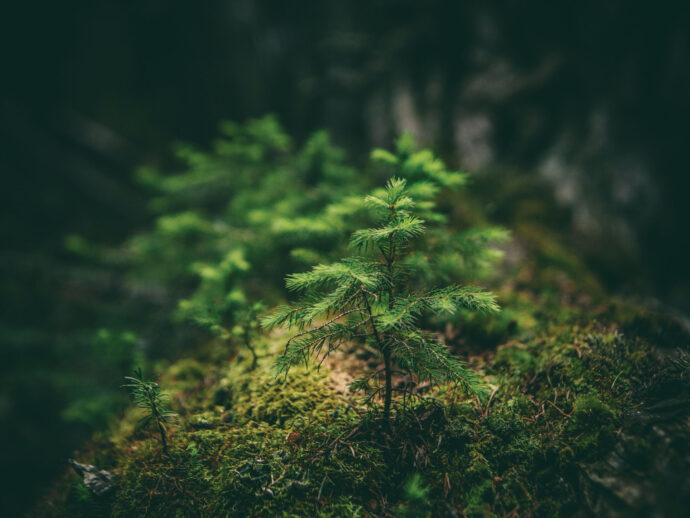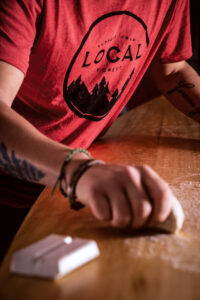
The lifestyle company tentree plants 10 trees for every garment sold, and is aiming to become the most environmentally progressive brand in the world. Here’s how they’re doing it, and why we’re cheering them on.
Aiming to become the most environmentally progressive brand on the planet sounds like an outlandish, grandiose goal—if not idealistically romantic. But after chatting with Sasha Bricel, marketing manager of the clothing and lifestyle brand tentree, it’s clear this company means business.
One billion trees
What sets tentree apart? It plants 10 trees for every item sold, and produces products with the highest sustainability standards on the market. Their goal? Planting 1 billion trees by 2030.
In the words of Bricel, “We aim to create a new path for the textile industry, one that prioritizes the health of the planet at every stage of production. We are committed to educating and supporting those in their path toward sustainability and providing our consumers with products they can feel proud to wear along the way.”
 A seed of an idea
A seed of an idea
In 2011, Kalen Emsley and David Luba found themselves hiking in Hawaii, in awe of the breathtaking landscape and wishing to do something to help protect the environment. Kalen, with a background in tree planting, and Dave, with a background in sales, began brainstorming how to combine their skills.
They realized that if they were to make and sell shirts, they would make enough to plant 10 trees per garment. They brought Kalen’s brother Derrick Emsley on board as CEO, and “tentree” was born.
The nitty gritty
To date, tentree has planted more than 25 million trees. The beautifully simple business model of planting 10 trees for every item sold “helps to offset carbon emissions, absorb CO2, restore ecosystems, combat deforestation, and provide food and shelter for animals,” says Bricel.
But it doesn’t end there. Everything from the materials to packaging and transportation are carefully thought through based on the environmental impact.
“We ask ourselves: ‘Where is it coming from and how is it transformed?’; ‘Are there any environmental and/or ethical questions?’; ‘What happens to that material at the end of its use or life?’; and ‘Is there a preferred option out there?’” explains Bricel.
“True sustainability for us is achieved when a material is fully renewable or indefinitely recyclable, that is, when it meets the principles of cradle-to-cradle rather than cradle-to-grave.”
They work closely with groups such as Textile Exchange and Sustainable Apparel Coalition, as well as accreditation and/or certification bodies, including Global Organic Textile Standard, Organic Cotton Standard, and Forestry Stewardship Council.
 Conscious clothing consumption
Conscious clothing consumption
The typical consumer purchased an estimated 60 percent more clothing in 2014 than in 2000, but only kept each item for half as long. We can be better consumers by buying responsibly, and maintaining clothing responsibly.
- Befriend your tailor and cobbler— repair before rebuying.
- Read clothing labels.
- Reach out to companies and let them know you care.
- Buy second-hand.
- Stay informed about the issues.
- Help educate others.
Looking ahead
I asked Bricel what motivates tentree, and her answers brim with enthusiasm and positivity: “Tentree is motivated by the hope to help end climate change and the destruction of our planet, through planting trees … by providing jobs, food, and shelter to hundreds of people in developing countries … by creating a culture of sustainability, and helping make sustainability accessible to everyone.”
And she assures me that they’re just getting started. They have a series of goals, starting with the aim of ensuring all their cotton is Fair Trade Organic or recycled by 2020. By 2025, all their products will be fully circular (either biodegradable or fully recyclable). By 2030, all their products will be C2C (carbon-neutral), with tree planting as the bonus.
“At tentree we built our business model on sustainability; that makes production and scaling a much harder and longer process, but we know it’s worth it,” says Bricel. “We hope to inspire a movement of people who want to make a difference and leave the planet better than they found it.”
A fashion fact
The fashion industry is responsible for an estimated 92 million tons of solid waste dumped in landfills each year.
A fashion wasteland
“The average consumer has no idea how many steps go into the making of a t-shirt,” says Bricel. “From growing cotton or extruding polyester filament to getting the finished product ready to be shipped to the end consumer, there could be over 20 different business entities involved, each with their own understanding of social and environmental compliance.”
Detail driven
Washing and drying clothing made from synthetic fibres releases microplastic into the water supply—including our drinking water. Enter tentree’s “guppyfriend washing bag.” Washing clothes in this keeps any microfibres from entering into waterways and also keeps clothes lasting longer.
What are you wearing
Clothing label term |
What does it mean? |
| zero waste | no waste created in the manufacturing and/or at the end of the garment’s life |
| vegan | no animal products used |
| dye free | no dyes used to colour the garment |
| Certified Organic | no toxic pesticides/fertilizers or genetically modified seeds used; healthy soil practices followed (look for a certification label such as GOTS for cotton) |
| local | no standardized definition: look for products made by companies, craftspeople, or entrepreneurs in your city/province/country |
| Fair Trade Certified | fair labour standards, such as no child labour used (look for a certification label) |
| Oekeo-Tex Certified | textile-specific certification that tests products for harmful substances |
| bluesign Certified | textile-specific certification that focuses on sustainability and safety through the production process |
| B Corp Certified | business certification that examines factors such as social responsibility, public transparency, and environmental performances |



































